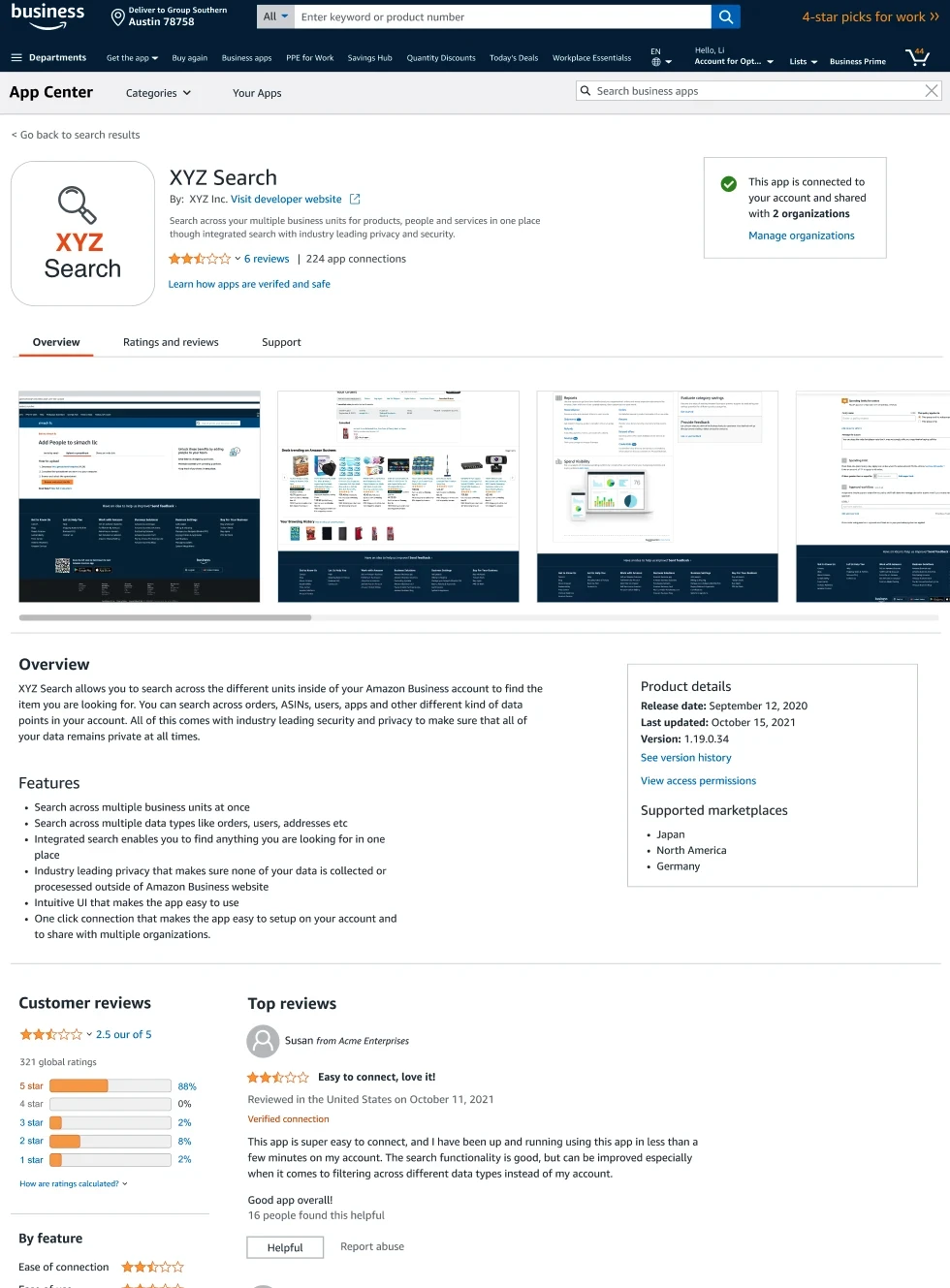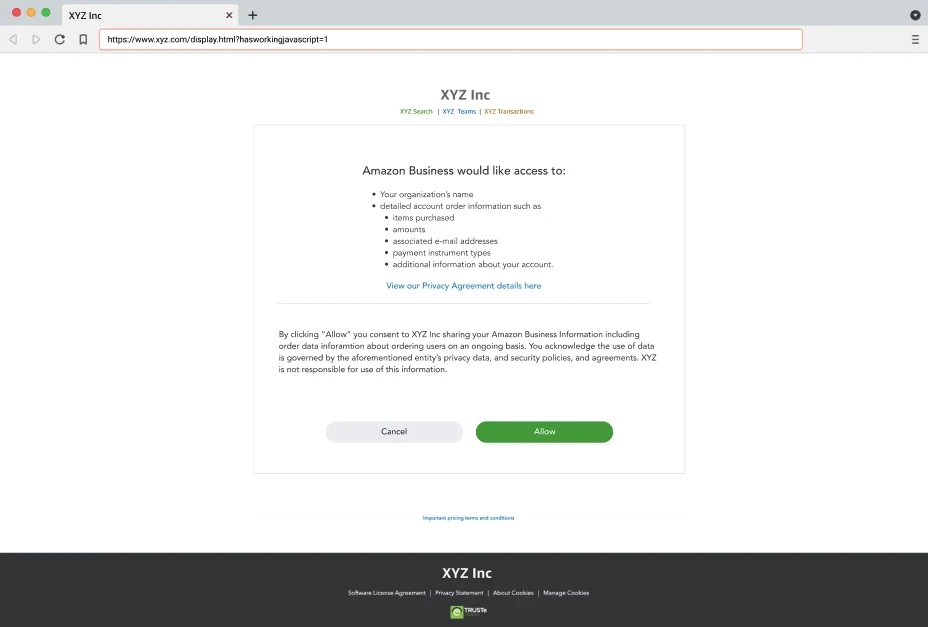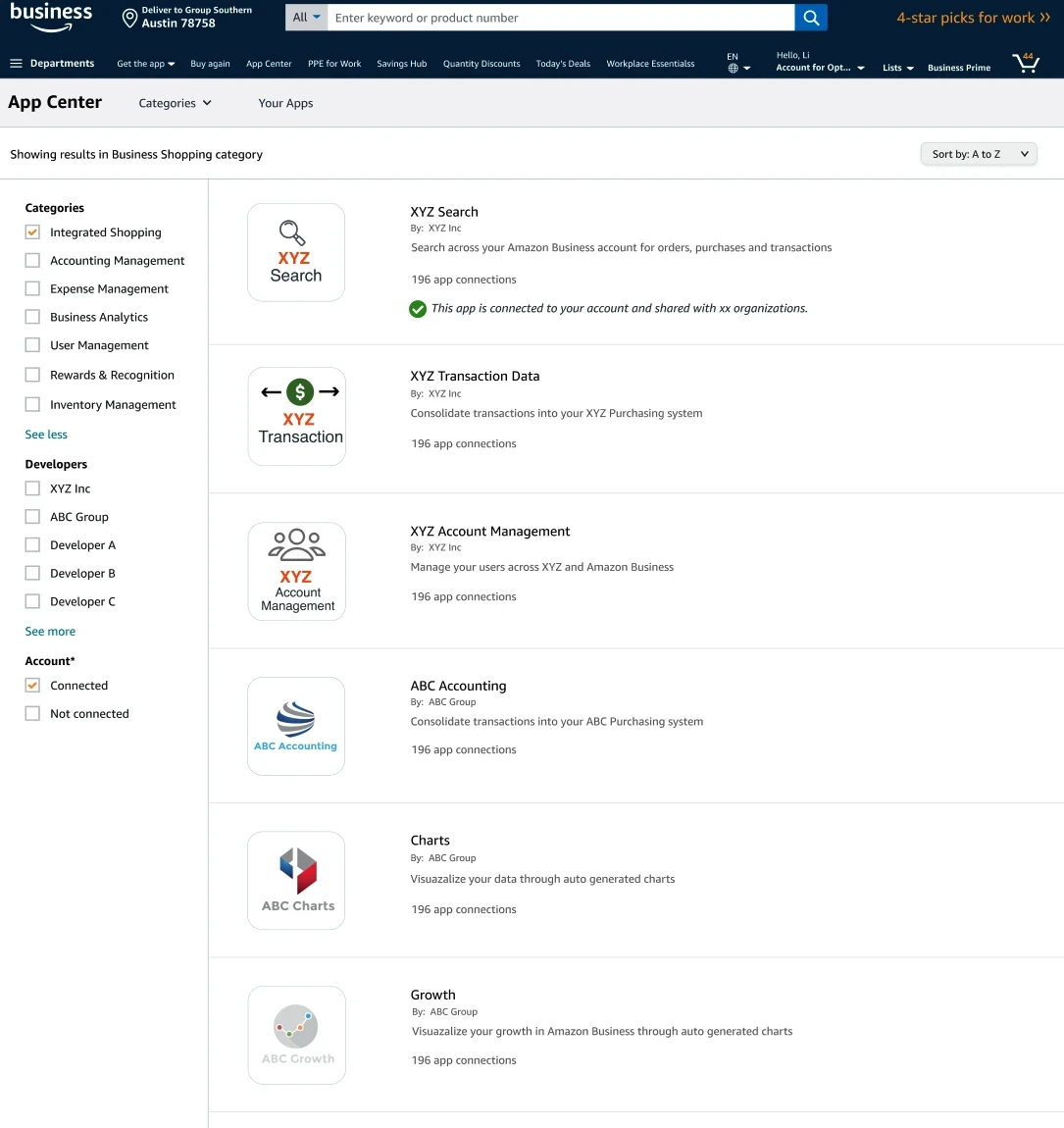Amazon business app STORE
AB App center
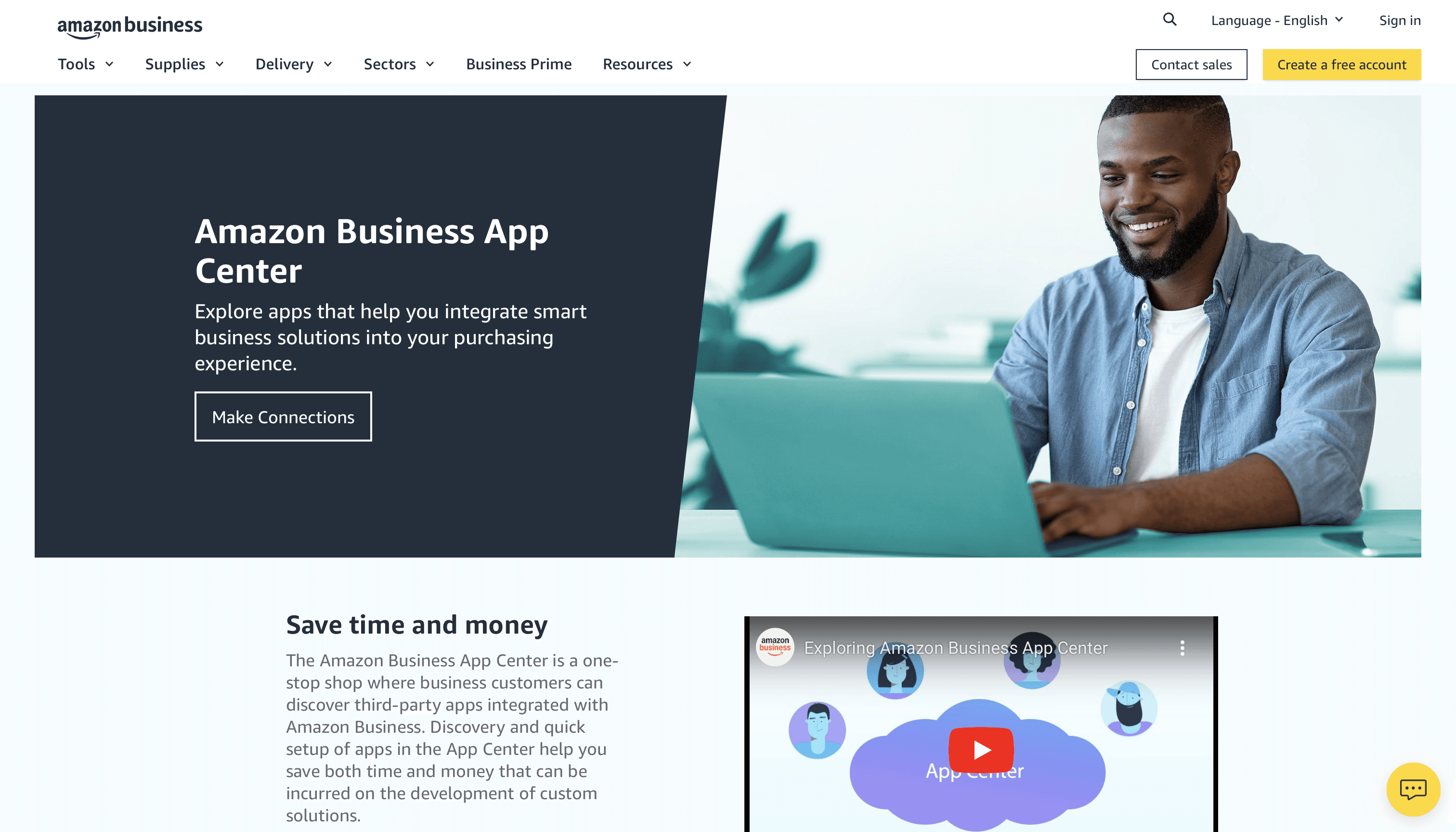
Process
Goals
Onboard 15 apps to App Center World Wide by EOY (2021) 5 months into launch
Drive 70K App Center-attributed app authorizations through features that include Marketing Hub and SEO enhancements
KPIs
Number of apps onboarded onto the app center
Customer bounce rate from the home page
Number of customer driven app connections
Impact & Outcome
22 apps onboarded onto the app center
(Goal: 15)
3.5% Customer bounce rate from the home page
219K Number of customer driven app connections
(Goal: 70K)
What is Amazon Business App Center?
The App center is a one stop shop for business customers of all sizes to discover and manage Amazon Business approved apps. Streamlined discovery of business apps help business customers improve their productivity, implement controls and focus on value add activities for their customers. This is the foundational step in making integrations self serve for amazon business customers, for all sizes and use cases.
The opportunity
Amazon Business offers integrations that allow customers to connect their systems with their Amazon Business account. However, these integrations are largely unknown, and customers cannot engage with them in a self-serve manner without reaching out to internal teams. The App Center aims to help customers discover, educate, integrate, monitor, and manage their integrations in a self-serve way without any prior requirements. While most integrations are API-driven, there is also scope for non-API cXML-based integrations as well.
Specific Challenges:
The main challenge will be educating customers that there are multiple ways to use amazon business beyond purchasing and procurement, and in an integration centric way as well.
Working to remain independent and have a unique identity to customers in the midst of other amazon-wide app centers, the amazon app, and the amaonz business app.
Working with partners to align on teh UI standards and app building, launching, and managing SOPs.
Incentivizing and advertising to app-developer partners to bridge customers bases and have them advocate for the app center.
Understanding the Users
User Segments
SSR (self serve registration) customers primarily with also CPS (Corporate & Public SEctor) who want to explore new ways to connect the platforms they use in their procurement journey with their amazon business account. This could include services like quickbook for easy bookkeeping, larger purchasing and reconcilaition systems for compliance and budget tracking and so on.
Goals
Enable customers to explore, discover, integrate with and manage integrations they find useful with their amazon business account. This could include services like quickbook for easy bookkeeping, larger purchasing and reconcilaition systems for compliance and budget tracking and so on.
Pain points
Right now, while Amazon business has the technology to enable these kind of integrations, there is no singular platform where customers can explore, learn about and connect integrations to their account in a self serve way without relying on the internal teams at amazon.
Customer Quotes
"I use Quickbooks online and would love to be able to import my purchases directly into Quickbooks Online. Is there a chance that this may happen?"
Ideal experience / customer journey
The experience of using an app center across business services remains lastly the same, but the detail license, making it to specific segments, which, in our case are the B2B procurement users. With this in mind, I mapped the journey below as a high-level representation of the actions customers can take out of the app center.
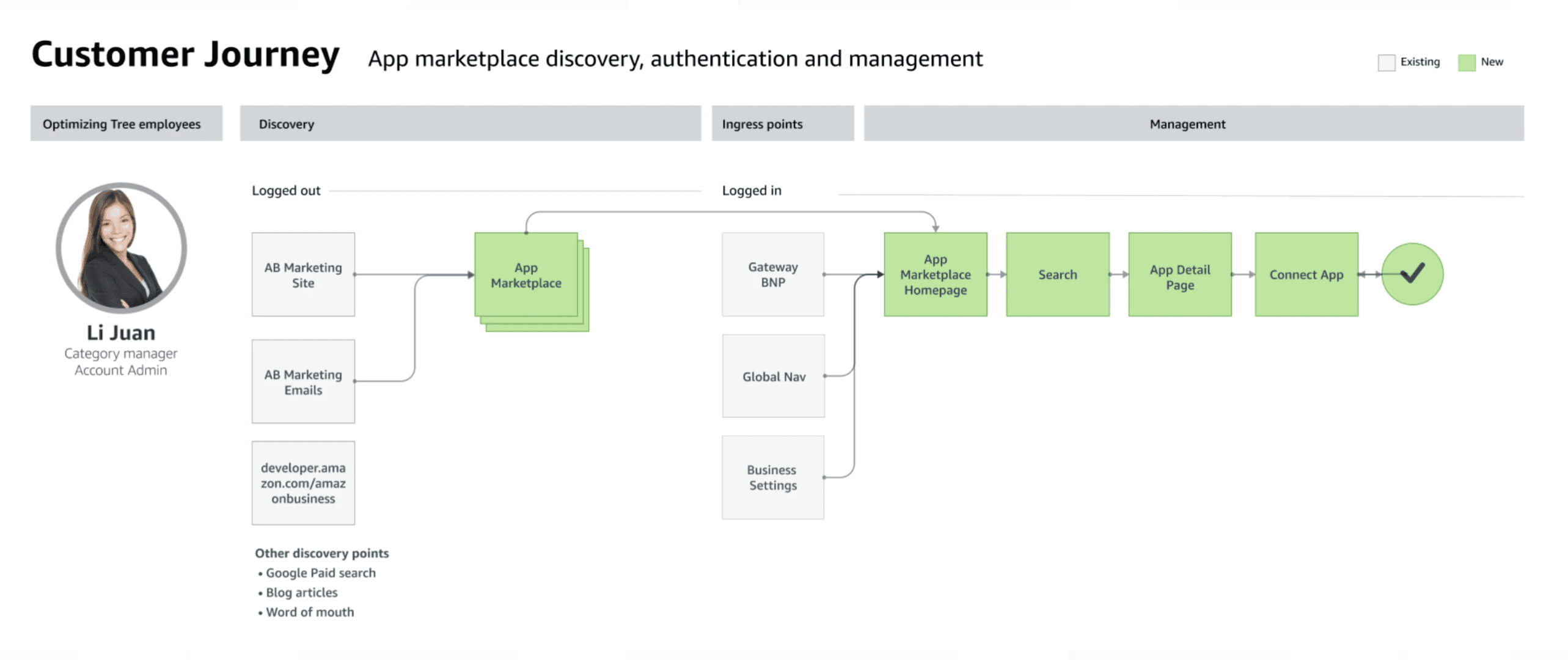
Ideation & Iterations
The process started with understanding what all goes into an app center. AWS has a pretty successful absent and most other services on the Internet that support integrations also support a similar app center.
Specific customer actions of discovery, search, understand, and connect. The app remain the same across different apps centers, so we had to not only meet the standards of the market, but also elevate the experience specifically for B2B customers.
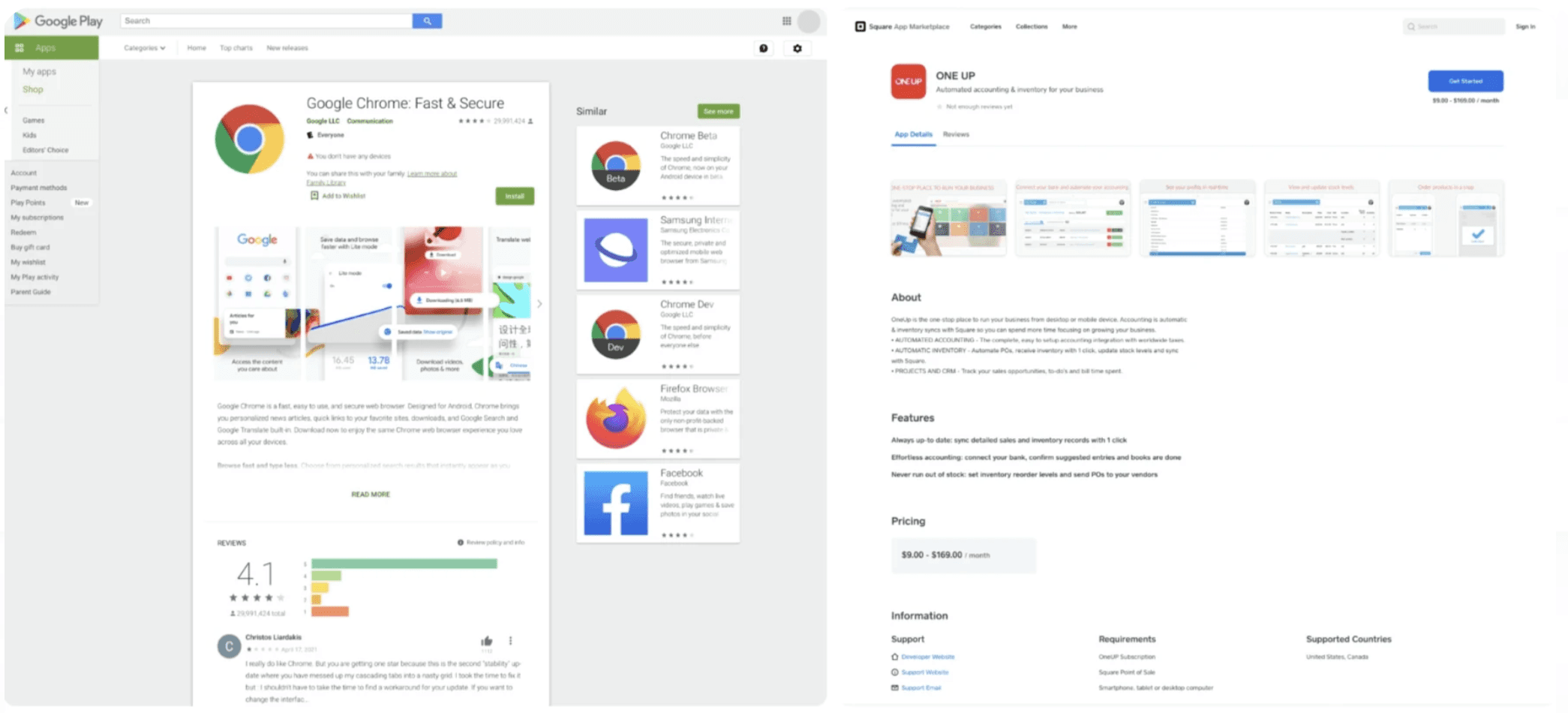
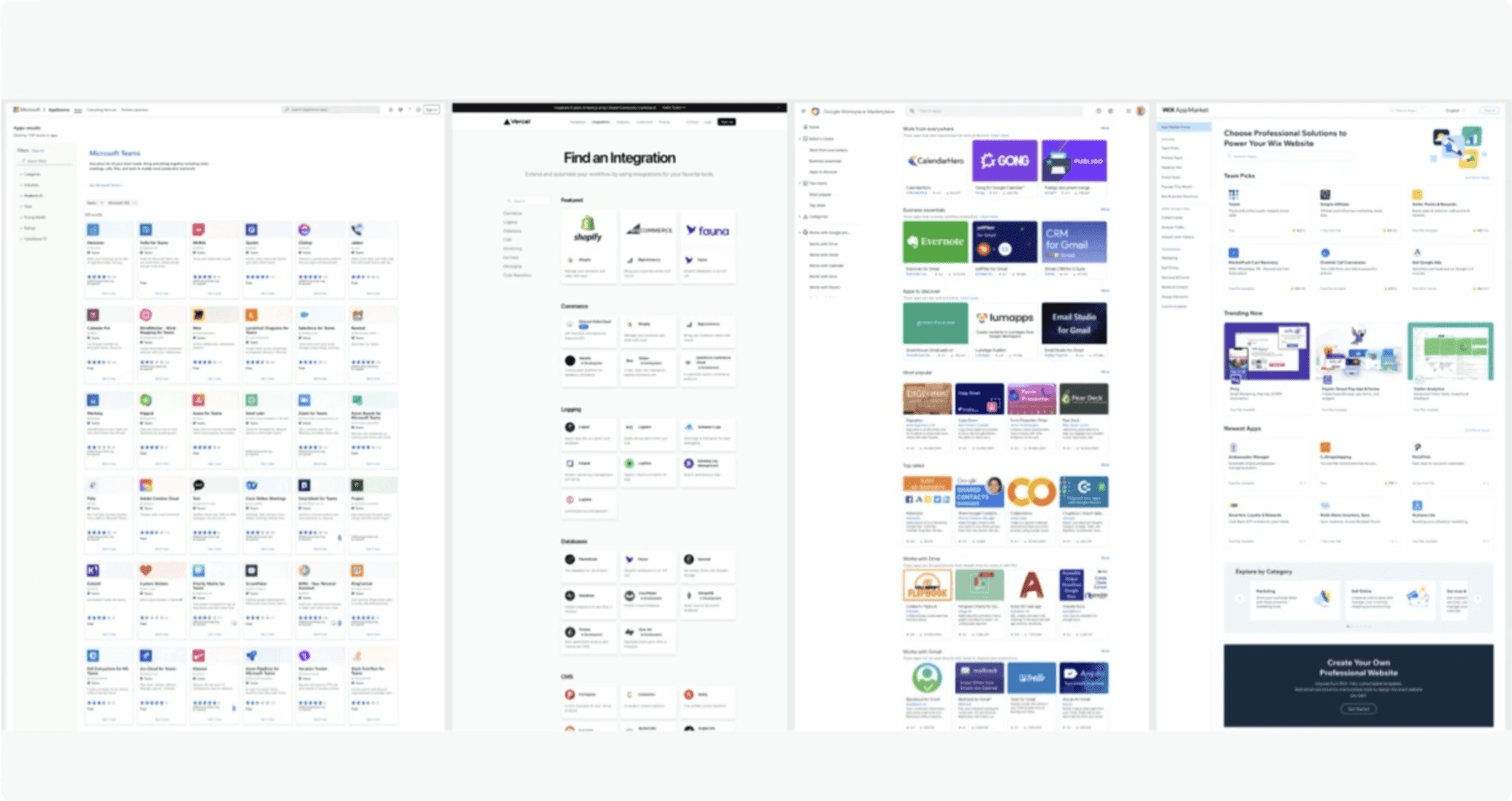
After doing the competitive analysis across multiple different app marketplace on the market, I was able to switch out a basic flow of all actions, decisions and outcomes. Customers can do or expect to do within the Amazon business app center. The diagram below is an early version of the possible flows through ingress, actions, decisions, and end state that I had come up with.
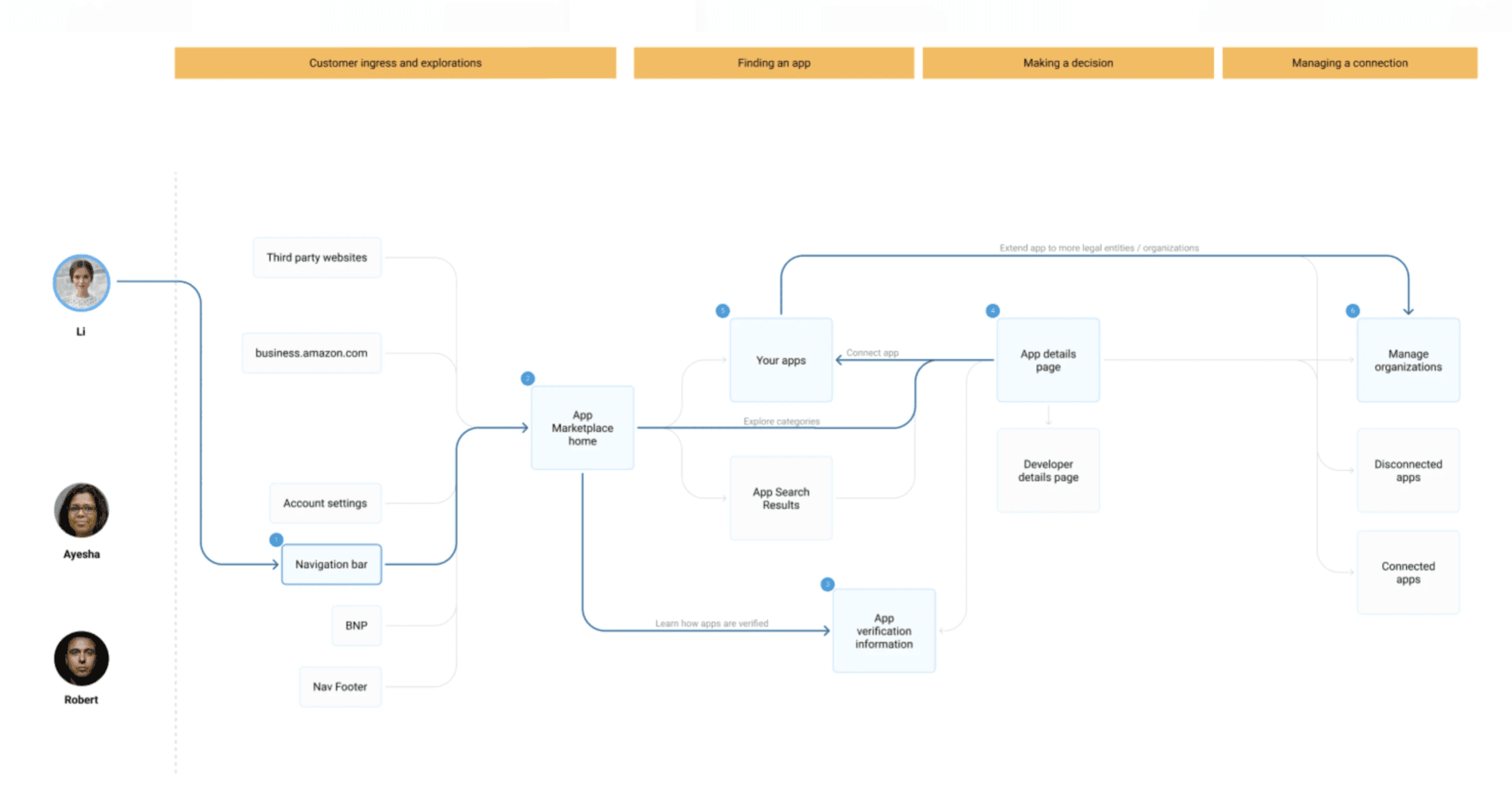
With this, I knew that I had to start with the homepage which was serve as the landing and discovery platform for customers. Below are a few more explorations of the home page, which would bring about a common UI language for the rest of the experience too.
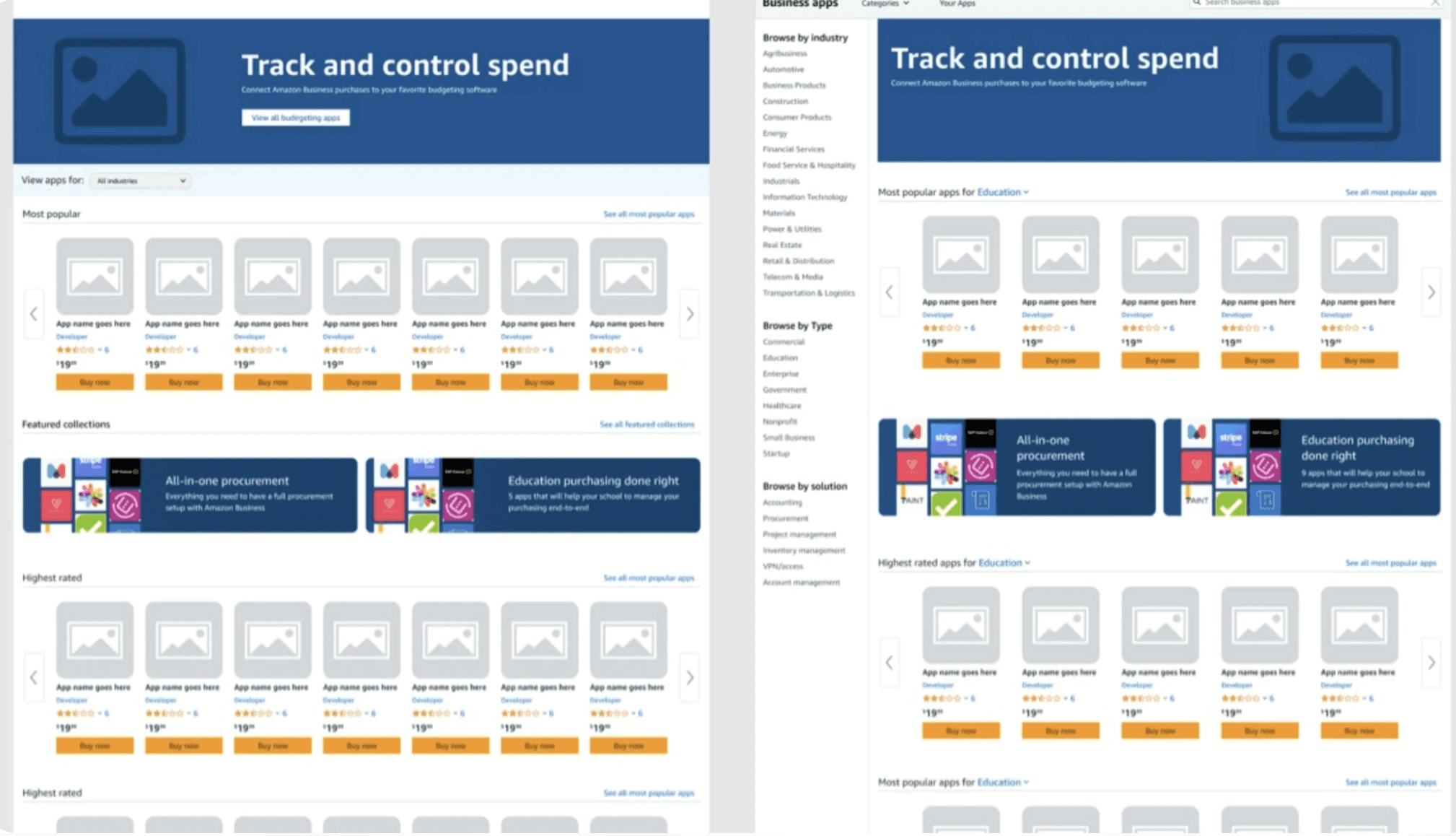
Design & Decisions
Amazon business customers also include corporate and public customers who have relatively large account structures with sensitive information about their purchases, addresses, and so on. We had to figure out a way to build trust with our customers, assuring them that the data they share with the apps are all encrypted, and the developers were listing their apps instead of the Amazon business apps center are already vetted.
Trusting could happen with two main things, one is explicitly stating it, and the other is to just bring in familiarity in terms of the interfaces with the customers. For the latter, I decided to use the Amazon product detail page, along with the rating of reviews which were instill a familiarity and trust inside the customers who are using the app center.
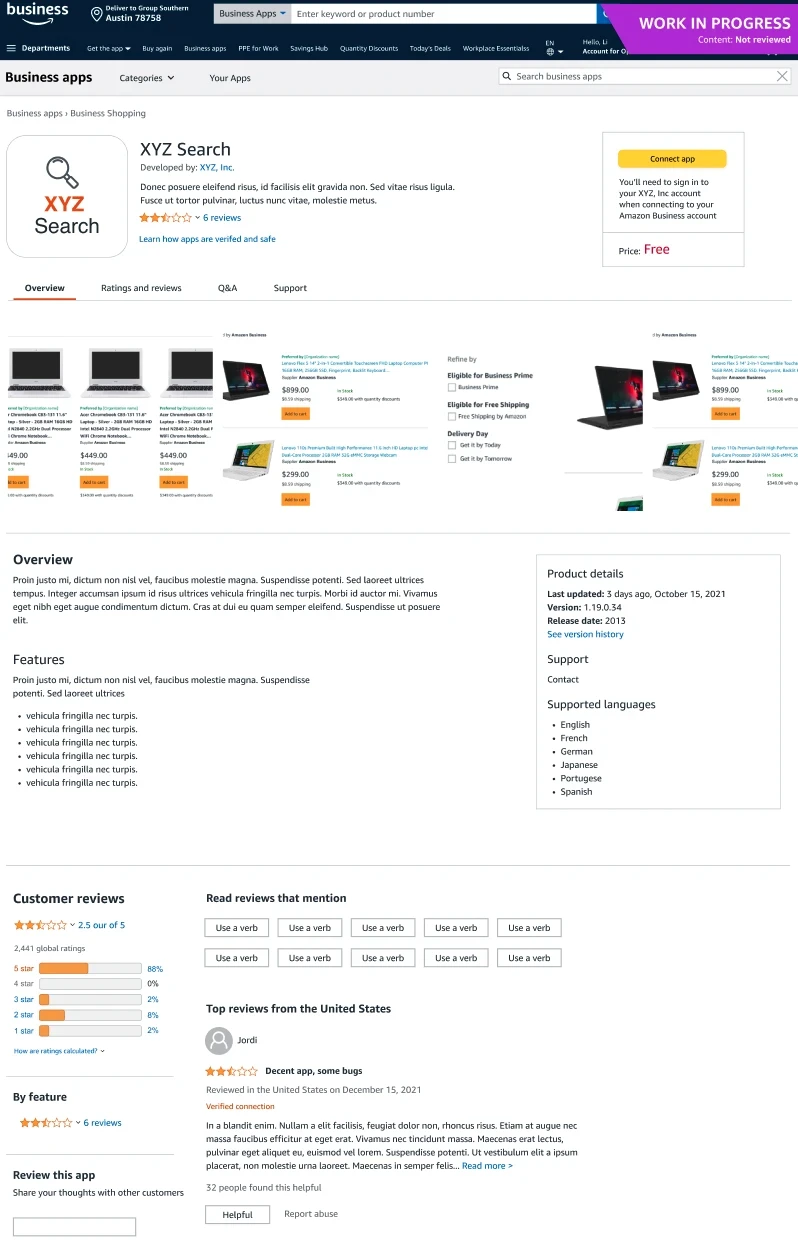
The final design of the Amazon business app center is true nature as being very similar to Amazon, product offerings, which are vastly familiar to customers and are intended to be just as trustworthy. Customers are able to explore different apps, app bundles, and connect an app with their account by logging into their 3P (app developer) account and consenting to the sharing of information between amazon business and the third party entity.
Conclusion
Outcome and Impact
The amazon business app center created a new way for cusotmers to explore and egage with integrations. This opened up a new segment of customrs who come to amaozn business not only for products but for integrations, and even services which can be lauched in the marketplace going forward. This is new revenue to the organiztion, and prvides apltform to create the self serve launchpad for integration sapce in amazon business.
We exceeded our goals of both onboarding 15 apps on the appcenter (total apps onboarded was 22), and also the number of customer driven app connections that happened within six months of the product's launch (Goal was 70K, but actual conenctions were 219K by EOY 2022). The app continues to grow to date, and is now a key, strategic part of the overall centralized integration vision inside of the Amazon business integrations space.
Learnings & Retrospective
Designing a launching a product of this scale has been very fulfilling, and given me a chance to engage in strategic decisions around what a product can be when it matures and set the direction for the vertical growth.
There were a lot of discussions, and setting the standard for a platform that is an enabler for services, integrations and products has been an exercise in customer activity at scale in the B2B segment.
The scale of the project was huge, and could not be covered in its entity in this case study, but designing for edge cases, complete handling, listing of an app and out the app, center and defining standard procedures of operation for customers and partners, give me a very deep insight into the inner workings of what really drives a marketplace.

